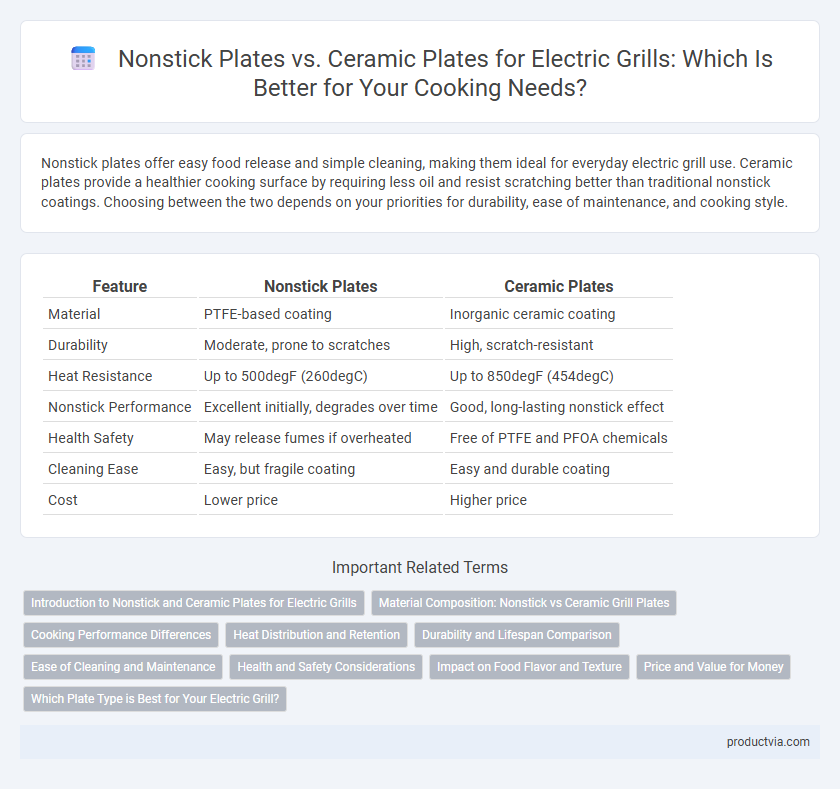Nonstick plates offer easy food release and simple cleaning, making them ideal for everyday electric grill use. Ceramic plates provide a healthier cooking surface by requiring less oil and resist scratching better than traditional nonstick coatings. Choosing between the two depends on your priorities for durability, ease of maintenance, and cooking style.
Table of Comparison
| Feature | Nonstick Plates | Ceramic Plates |
|---|---|---|
| Material | PTFE-based coating | Inorganic ceramic coating |
| Durability | Moderate, prone to scratches | High, scratch-resistant |
| Heat Resistance | Up to 500degF (260degC) | Up to 850degF (454degC) |
| Nonstick Performance | Excellent initially, degrades over time | Good, long-lasting nonstick effect |
| Health Safety | May release fumes if overheated | Free of PTFE and PFOA chemicals |
| Cleaning Ease | Easy, but fragile coating | Easy and durable coating |
| Cost | Lower price | Higher price |
Introduction to Nonstick and Ceramic Plates for Electric Grills
Nonstick plates for electric grills are coated with materials like Teflon, providing easy food release and effortless cleaning, ideal for low to medium heat cooking. Ceramic plates offer a natural, chemical-free surface that heats evenly and can withstand higher temperatures, enhancing searing and browning. Both options contribute to healthier cooking by reducing the need for excessive oils, with ceramic plates often preferred for durability and eco-friendliness.
Material Composition: Nonstick vs Ceramic Grill Plates
Nonstick plates for electric grills typically feature a Teflon or PTFE coating that offers excellent food release and easy cleaning but may degrade under high temperatures or scratching. Ceramic grill plates consist of a silica-based material that provides superior heat retention, is naturally nonstick without chemical coatings, and withstands higher temperatures safely. Choosing between nonstick and ceramic plates depends on durability preferences and cooking style, with ceramic plates favored for eco-friendly, long-lasting use and nonstick plates for convenience and quick clean-up.
Cooking Performance Differences
Nonstick plates provide consistent heat distribution with minimal food adhesion, allowing for easier cooking and cleanup on electric grills. Ceramic plates offer superior heat retention and can reach higher temperatures, which enhances searing and caramelization of meats and vegetables. Both materials impact cooking performance, but ceramic plates excel in delivering crisp textures while nonstick plates prioritize ease of use and maintenance.
Heat Distribution and Retention
Nonstick plates on electric grills offer rapid heat distribution and excellent retention, ensuring even cooking without hot spots, ideal for quick meals. Ceramic plates provide superior heat retention with a slightly slower heat-up time, maintaining consistent temperatures longer for more thorough cooking. Both materials enhance grilling performance, but ceramic excels in uniform heat retention while nonstick prioritizes fast, even heating.
Durability and Lifespan Comparison
Nonstick plates on electric grills typically offer superior durability due to their resistance to scratches and peeling, extending their lifespan with proper care. Ceramic plates, while less prone to chemical degradation and providing even heat distribution, are more fragile and susceptible to chipping or cracking over time. Choosing between nonstick and ceramic plates ultimately depends on balancing durability preferences with heat performance and maintenance requirements.
Ease of Cleaning and Maintenance
Nonstick plates on electric grills offer superior ease of cleaning due to their smooth, slick surface that prevents food from sticking, allowing for quick wiping after use. Ceramic plates, while more durable and resistant to scratches, require more thorough scrubbing to remove food residues and occasional seasoning to maintain their nonstick qualities. Choosing nonstick plates reduces maintenance time, whereas ceramic plates demand more care but provide long-lasting performance.
Health and Safety Considerations
Nonstick plates for electric grills often contain coatings like PTFE, which can release harmful fumes if overheated, raising health concerns. Ceramic plates provide a chemical-free, non-toxic alternative that resists high temperatures without degrading or emitting hazardous substances. Choosing ceramic plates enhances safety by reducing exposure to potentially dangerous chemicals during cooking.
Impact on Food Flavor and Texture
Nonstick plates in electric grills create a smooth surface that prevents food from sticking, preserving moisture and enhancing natural flavors without added oils. Ceramic plates offer more even heat distribution, which promotes consistent cooking and can develop a richer, slightly caramelized texture in grilled foods. Both materials influence texture and flavor by controlling cooking temperature and food release, but ceramic plates often yield a more pronounced sear and crispness.
Price and Value for Money
Nonstick plates for electric grills are generally more affordable, offering good value for money due to their ease of cleaning and consistent performance. Ceramic plates tend to be pricier but provide superior heat distribution and durability, which may justify the investment for frequent grill users. Evaluating the balance between initial cost and long-term benefits helps determine the best choice for budget-conscious buyers seeking efficient cooking surfaces.
Which Plate Type is Best for Your Electric Grill?
Nonstick plates offer effortless food release and easy cleaning, making them ideal for everyday grilling with minimal maintenance. Ceramic plates provide superior heat retention and are free from harmful chemicals, appealing to health-conscious users who prioritize eco-friendly materials. Choosing the best plate depends on your cooking habits: nonstick plates suit quick, casual grilling, while ceramic plates excel in consistent heat and durability for more frequent use.
Nonstick plates vs Ceramic plates for electric grills Infographic

 productvia.com
productvia.com